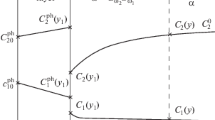Abstract
A computer-based method is used to simulate the process of penetration of a foreign element (e.g., oxygen) into an alloy connected with internal precipitation of a compound of this element with a solute in the alloy. The method employed is based on the solution of the differential equations corresponding to this high-temperature corrosion phenomenon with the help of the finite-difference technique. To demonstrate the possibilities of the calculation method, various cases were treated which differ especially regarding the thermodynamic stability of the internal precipitates. The calculated concentration profiles and penetration depths obtained are reported and discussed. In the case of internal precipitates of high stability, the results are compared with the approaches derived in the literature for internal oxidation and are used to determine the parameter ranges in which the analytical equations apply. The results obtained for the case of a less-stable compound is used to illustrate the influence of the solubility product on the concentration profiles.
Similar content being viewed by others
References
H. J. Christ, W. Christl, and H. G. Sockel,Werkst. Korr. 37, 385 (1986).
W. Christl, H. J. Christ, and H. G. Sockel,Werkst. Korr. 37, 437 (1986).
H. G. Sockel and H. J. Christ,Mater. Sci. Eng. 87, 119 (1987).
F. N. Rhines,Trans. Am. Inst. Min. Metall. Pet. Eng. 137, 246 (1940).
L. S. Darken,Trans. Am. Inst. Min. Metall. Pet. Eng. 150, 157 (1942).
J. L. Meijering and M. J. Druyvesteyn,Philips Res. Rep. 2, 81, 260 (1947).
C. Wagner,Z. Elektochemie 63, 772 (1959).
R. A. Rapp,Corrosion NACE 21, 382 (1965).
P. Kofstad,High-Temperature Corrosion (Elsevier Applied Science, London, 1988), pp. 324–341.
F. N. Rhines, W. A. Johnson, and W. A. Anderson, Appendix inAmerican Documentation Institute (document no. 1558).
J. Crank,The Mathematics of Diffusion (Clarendon Press, Oxford, 1975).
K. Bongartz, D. F. Lupton, and H. Schuster,Met. Trans. A 11A, 1883 (1980).
K. Bongartz, R. Schulten, W. J. Quadakkers, and H. Nickel,Corrosion NACE 42, 390 (1986).
I. Barin and O. Knacke,Thermochemical Properties of Inorganic Substances (Springer, Berlin, 1977).
H. Jehn, H. Speck, W. Hehn, E. Fromm, and G. Hörz, InPhysikdaten/Physics Data, Gases and Carbon in Metals (Thermodynamics, Kinetics, and Properties), XIV: Ferrous Metals (2), H. Behrens and G. Ebel, eds. (Fachinformationszentrum Energie-Physik-Mathematik, Karlsruhe, 1981).
H. J. Penkalla, V. Guttmann, and J. Timm,Proceedings of the Petten International Conference on Interactions between Corrosion and Mechanical Stress, May 1980 (Applied Science, London, 1981), p. 389.
J. M. Harrison, J. F. Norton, R. T. Dericott, and J. B. Mariott,Werkst. Korr. 30, 783 (1979).
Author information
Authors and Affiliations
Rights and permissions
About this article
Cite this article
Christ, H.J., Biermann, H., Rizzo, F.C. et al. Influence of the solubility product on the concentration profiles of internal oxidation. Oxid Met 32, 111–123 (1989). https://doi.org/10.1007/BF00665271
Received:
Revised:
Issue Date:
DOI: https://doi.org/10.1007/BF00665271




